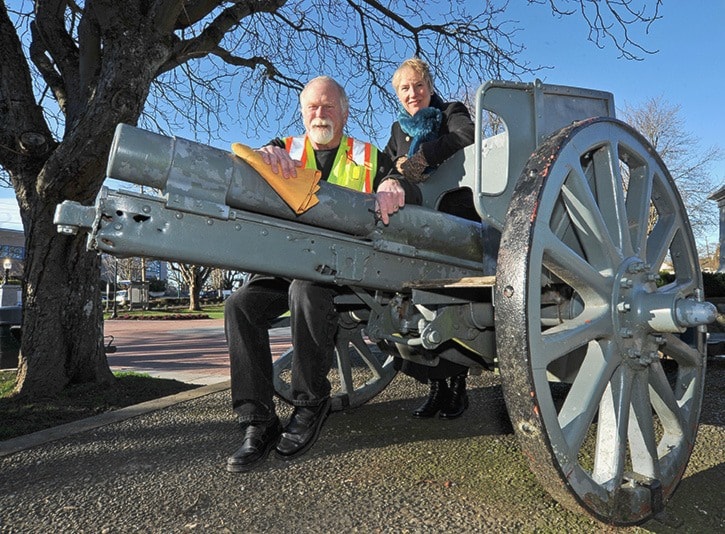Look closely at the smaller of the two 77 mm field guns in Esquimalt's Memorial Park and its battle-weary wounds begin to show.
The punctured metal hints at shots fired by the 2nd Canadian Mounted Rifles before they overwhelmed the Germans at Vimy Ridge on April 9, 1917. The regiment, made up of mostly Victoria-based soldiers, captured the anti-tank gun as one of nearly 400 war trophies that would eventually make their way into the hands of Canadian municipalities following the First World War.
"This is a storm trooper gun," says Mike Reed with Esquimalt's public works department. "The Germans put smaller wheels on it and stripped the unnecessary pieces so troops could pull to the frontline and embed it tighter to the ground."
Across the park sits a German 77 mm Feldkanone 96 neuer Art Field Gun, a tongue-twisting name for a similar weapon with larger wheels and shielding taken at the second battle of Cambai on Sept. 29, 1918.
Together, they comprise two of only three known First World War German field guns in the province, says Colin Wyatt with the Ashton Armoury and Museum in Saanich.
"Most of these guns went back into scrap at the beginning of World War II," Wyatt says.
Three-quarters of Canada's war trophy guns were melted down for scrap metal as the war machine ramped up once again, including two similar weapons on the grounds of the B.C. legislature in 1941 (see photo).
ABOVE: Victoria Daily Times/Esquimalt Archives
"Apparently, there was another gun at Beacon Hill Park and one in Oak Bay, but Esquimalt's are the only two that were saved when we incorporated them as part of our war memorial," Reed says.
On Feb. 11, public works staff removed the guns to begin glass-beaded blasting and refurbishment of corroded metal parts in the run-up to the 100th anniversary of the start of the First World War in August.
"In the last number of years, we've seen the Naval Centennial, the Esquimalt Centennial and now we're looking at the First World War centennial leading up to the 150th anniversary of Canada," said Mayor Barb Desjardins. "The connection for our community with the military is huge, and there's a lot of people who still miss that connection to the army. I had a grandfather at Vimy Ridge."
When the Canadian government gifted Esquimalt the guns in 1920, they were sited at Lampson elementary for five years to commemorate students who had lost their lives in the Great War.
Desjardins said the township will put a memorial plaque at Lampson to recognize that history as well.
In the meantime, Reed and Wyatt continue their feverish research to restore the guns as accurately as possible to their original colour and style.
"Nobody seems to know what the true colour was," Wyatt says. "I think they must have had these guns in different colours – not intentionally, they were all meant to be field green – but they varied from match to match.
"People may have relatives who were involved in the fighting of these battles. We'd love to find out more about the history of those guns. We also don't have any photographs of when they were first brought to Esquimalt, so we'd like to see those if they're around."
Reed hopes to return the field guns to Memorial Park in July, as well as install accent lighting on the platforms surrounding the war memorial.
"I'm dealing with some Pennsylvania guys who restored a piece like this 20 years ago," he says. "They're sending me colour samples on little sticks. So we're really trying to get this right."
ABOVE: An undated photo from the Esquimalt Archives shows Canadian soldiers with an Esquimalt banner.
DID YOU KNOW?
Library and Archives Canada records show the 2nd Canadian Mounted Rifles Regiment (CMR) was organized in December 1914 under the command of Lt.-Col. C.L. Bott. The regiment was mobilized at Willows Camp in Oak Bay and recruited from 30th B.C. Horse (Vernon) and Victoria Squadron of Horse. The regiment left Montreal in June 1915 aboard Megantic bound for England. Its strength was 28 officers and 605 other ranks.
